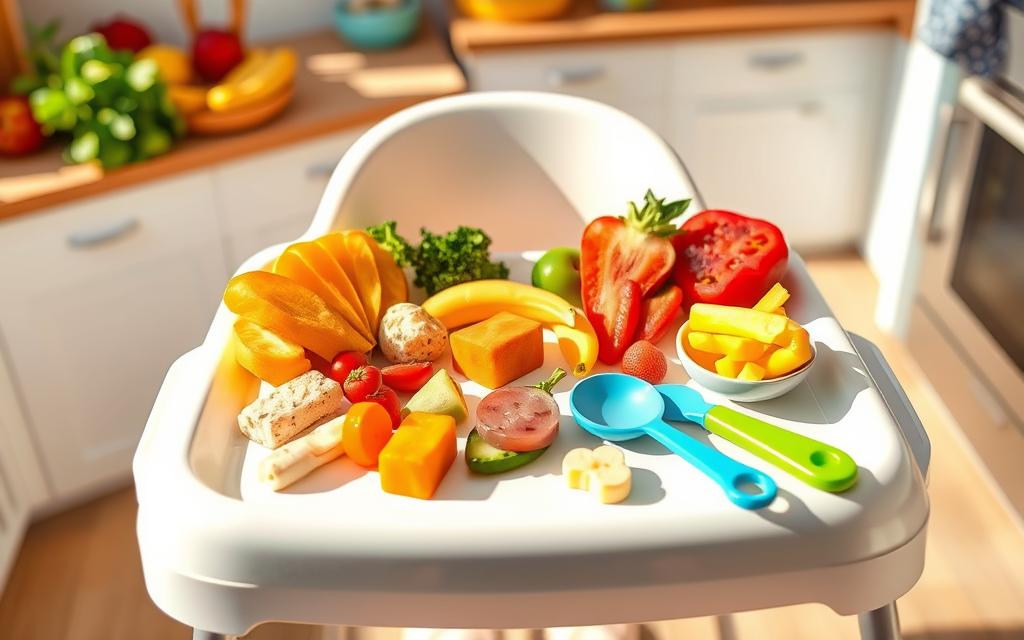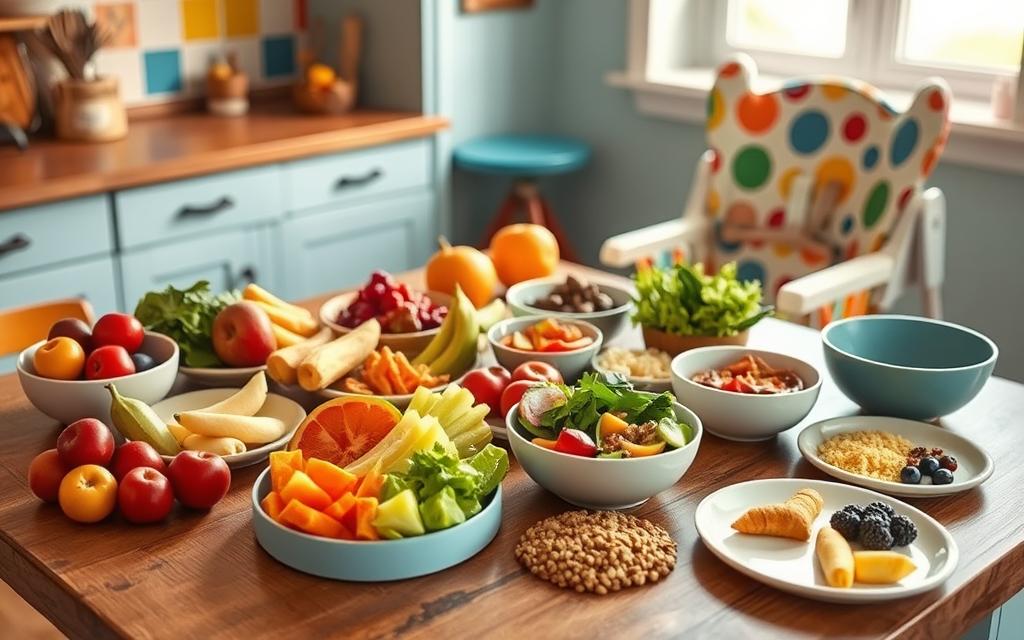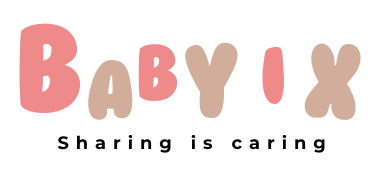Your Essential Guide to Baby-Led Weaning

Welcome to the world of baby-led weaning. It’s a method where your baby gets to choose their own food. We’re here to guide you through it, from the basics to more advanced topics. Our aim is to make this journey easy for you.
This guide will show you how to make a safe space for your baby to try new foods. We’ll talk about the benefits, how to start, and what to expect. Whether you’re new to this or need tips to overcome challenges, we’ve got you covered.
Key Takeaways
- Baby-led weaning is an approach that lets your baby take the lead in introducing solids
- Our guide provides a comprehensive resource for baby-led weaning for beginners
- We’ll cover topics such as safety, nutrition, and common challenges
- Creating a supportive environment is key to successful baby-led weaning
- Our guide is designed to be a trusted resource for parents looking for a baby-led weaning guide
Understanding Baby-Led Weaning Fundamentals
Starting baby-led weaning means understanding its core principles. This method lets babies feed themselves, trying new tastes and textures. It’s all about letting them explore at their own pace, promoting independence and curiosity.
Baby-led weaning is about creating a space for exploration and learning. Parents guide and supervise, but let the baby lead. This helps babies learn important skills like hand-eye coordination and self-feeding.
Key Principles of Baby-Led Weaning
- Self-feeding: Babies are encouraged to feed themselves, using their hands and mouth to explore different foods.
- Exploration: Babies are given the freedom to discover new tastes, textures, and smells, promoting a positive relationship with food.
- Parental guidance: Parents provide support and supervision, ensuring their baby’s safety while eating.
When introducing solids, remember baby-led weaning is not a one-size-fits-all. It’s important to be flexible and adapt to your baby’s needs and preferences. Understanding baby-led weaning helps parents make informed decisions about their baby’s eating journey, setting them up for a lifetime of healthy eating habits.
The Science-Backed Benefits of Baby-Led Weaning
Studies show that baby-led weaning boosts motor skills. Babies learn to handle solid foods by themselves. This method also promotes healthy eating habits. Babies are more open to trying different foods when they control their meals.
Some key benefits of baby-led weaning include:
- Reduced pickiness, as babies are exposed to a wide range of flavors and textures
- Improved digestion, as babies learn to chew and swallow solid foods at their own pace
- Enhanced cognitive development, as babies learn to problem-solve and navigate mealtime
Baby-led weaning benefits aren’t just for babies. It also helps parents feel less stressed and anxious. By letting babies lead, parents can feel more confident in feeding their child healthily.
The science supports baby-led weaning as a great start for solid foods. Knowing these benefits helps parents feel sure about choosing this method.
When to Start Your Baby-Led Weaning Journey
Starting baby-led weaning is a big step for parents and babies. It’s important to know when your baby is ready. Every baby grows at their own pace, so be patient.
Look for signs that your baby is ready for solid foods. They should be able to sit up with support and show interest in food. These are good signs they’re ready to start eating solids.
Key Developmental Signs of Readiness
- Showing interest in food and mealtime
- Able to sit up with support and maintain good posture
- Having the necessary motor skills for self-feeding, such as grasping and releasing objects
When starting baby-led weaning, always put your baby’s safety first. Watch them closely during meals. Make sure they’re comfortable and can handle solid foods. With love and the right steps, you and your baby will have a great time with baby-led weaning.
Safety First: Essential Baby-Led Weaning Guidelines
When it comes to baby-led weaning, safety is key. Parents should follow best practices for baby-led weaning to keep their baby safe. This includes watching over them, preventing choking, and being aware of allergies. Never leave a baby alone while they’re eating, as this can lead to accidents.
Parents should know about foods that can cause choking, like nuts, seeds, and popcorn. They should cut food into small, easy-to-manage pieces. It’s also important to watch for signs of an allergic reaction, such as rashes, itching, or swelling. If any of these symptoms show up, get medical help right away.
- Always supervise mealtime
- Cut food into small pieces to reduce choking risk
- Be aware of possible allergens and introduce new foods slowly
- Never leave a baby alone while eating
By sticking to these guidelines and best practices for baby-led weaning, parents can make sure their baby is safe. This way, they can enjoy exploring food and learn good eating habits.
Best First Foods for Baby-Led Weaning Success
Choosing the right foods is key for a successful baby-led weaning journey. Around six months, babies are ready to try solid foods. It’s important to give them foods that are full of nutrients to help them grow.
Soft fruits like avocados and bananas are great first foods. So are steamed veggies like broccoli and carrots. These foods are full of vitamins and minerals. They’re also easy for babies to hold and chew, which helps avoid choking.
Ideal Fruit and Vegetable Options
- Avocados: rich in healthy fats and fiber
- Bananas: good source of potassium and vitamins
- Broccoli: packed with vitamins and antioxidants
- Carrots: high in vitamin A and fiber
Protein-Rich Starter Foods
Protein-rich foods like chicken and fish are also good for baby-led weaning. They help with muscle growth. You can bake or steam them to make them safe for babies.
Foods to Completely Avoid
Some foods are not safe because of allergy risks or choking hazards. Avoid nuts, seeds, and hard candies. It’s good to offer a variety of foods to help babies develop healthy eating habits and lower the chance of food allergies.
| Food | Benefits | Risks |
|---|---|---|
| Avocados | Rich in healthy fats and fiber | None |
| Nuts | High in protein and healthy fats | Allergy risk and choking hazard |
Setting Up Your Baby-Led Weaning Environment
Creating a comfy and supportive space is key for baby-led weaning success. This method lets your baby explore food at their own pace. It makes mealtime a fun learning experience. To get it right, consider these baby-led weaning tips: get a good high chair and bib to keep messes down and clothes clean.
A sturdy, adjustable high chair keeps your baby safe and comfy. A bib with a crumb pocket helps catch spills. These baby-led weaning tips help make a space for exploration and learning.
Essential Equipment and Tools
- High chair with a sturdy base and adjustable height
- Bib with a crumb-catcher pocket
- Soft, easy-to-clean tablecloth or placemat
- Small, soft-bristled brush for cleaning teeth and gums
Creating a Safe Eating Space
For a safe eating area, think about comfort, cleanliness, and few distractions. By following these baby-led weaning tips, you can help your baby develop good eating habits. This also builds a positive food relationship.
| Equipment | Purpose |
|---|---|
| High chair | Supports baby during meals |
| Bib | Protects clothing from stains |
| Tablecloth or placemat | Contains messes and makes cleanup easier |
Common Challenges in Baby-Led Weaning and Solutions
Starting baby-led weaning can be thrilling yet daunting. It brings many benefits but also unique challenges. One big issue is the mess it can make. Mealtime can become chaotic, but with the right tips, you can handle it well.
Managing your expectations is another challenge. Remember, baby-led weaning is a journey, and progress may vary. Some days will be better than others. But with patience and persistence, you and your baby will find a good rhythm.
Handling food refusal is also common. The key is to offer many foods and not to force feeding. Let your baby explore different tastes and textures at their own pace.
Here are some tips to help you overcome common challenges:
- Start with soft, easy-to-grasp foods to reduce the risk of choking and make mealtime less messy.
- Be prepared for messes by using a splat mat or placing a vinyl tablecloth under your baby’s eating area.
- Offer a variety of foods to ensure your baby is getting a balanced diet and to reduce the risk of food refusal.
By following these tips and staying committed, you can help your baby develop healthy eating habits. Remember, every baby is different. Stay flexible, and don’t hesitate to reach out to your pediatrician if you have concerns about your baby’s eating habits or overall health.
| Challenge | Solution |
|---|---|
| Messy mealtime | Use a splat mat or vinyl tablecloth |
| Managing expectations | Understand that progress may vary and be patient |
| Food refusal | Offer a variety of foods and don’t force feeding |
Meal Planning and Preparation Tips for Success
Starting baby-led weaning means planning and preparing meals carefully. Begin by making a weekly menu with different foods. Include fruits, veggies, proteins, and whole grains.
It’s important to make meals nutritious and easy for your baby to eat. Cut food into small pieces and cook until tender. Offer various textures to keep meals fun. These steps help your baby develop good eating habits and enjoy whole foods.
Weekly Menu Planning Ideas
- Offer a variety of fruits and vegetables, such as mashed sweet potatoes and steamed broccoli
- Incorporate protein-rich foods, like chicken and fish, into meals
- Include whole grains, such as brown rice and quinoa, in meals
Food Preparation Techniques
Food safety is key when preparing for baby-led weaning. Wash hands often, clean surfaces and utensils, and cook foods to the right temperature. These steps prevent foodborne illness and ensure a healthy weaning experience.

Storage and Portioning Guidelines
Storing and portioning food in advance can make mealtime easier. Prepare big batches of food like soups and stews, and freeze them. These tips help make introducing solids a positive experience and encourage healthy eating habits for life.
| Food | Portion Size | Storage Tips |
|---|---|---|
| Fruits and Vegetables | 1-2 cups per serving | Store in airtight containers in the refrigerator |
| Proteins | 2-3 ounces per serving | Store in airtight containers in the refrigerator or freezer |
| Whole Grains | 1/2 cup per serving | Store in airtight containers at room temperature |
Conclusion: Embracing Your Baby-Led Weaning Adventure
Starting your baby-led weaning journey is exciting and a bit challenging. Every baby is different, so what works for one might not work for another. With patience, flexibility, and your pediatrician’s help, you can face this adventure with confidence.
Baby-led weaning has many benefits. It helps your baby develop healthy eating habits and a positive food relationship. By letting your baby explore new tastes and textures at their own speed, you’re helping them enjoy meals for years to come.
So, don’t worry about the mess and enjoy the happy moments. Trust that your baby is leading the way. With the right advice and a supportive community, mealtimes can become special times for bonding, learning, and exploring the world of food together.





